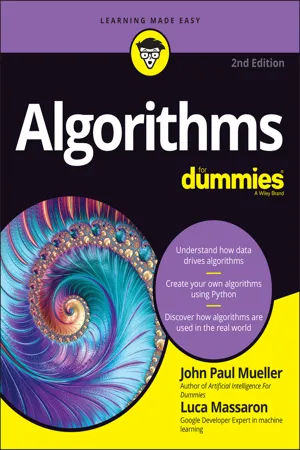
- English
- ePUB (mobile friendly)
- Available on iOS & Android
Algorithms For Dummies
About This Book
Your secret weapon to understanding—and using!—one of the most powerful influences in the world today
From your Facebook News Feed to your most recent insurance premiums—even making toast!—algorithms play a role in virtually everything that happens in modern society and in your personal life. And while they can seem complicated from a distance, the reality is that, with a little help, anyone can understand—and even use—these powerful problem-solving tools!
In Algorithms For Dummies, you'll discover the basics of algorithms, including what they are, how they work, where you can find them (spoiler alert: everywhere!), who invented the most important ones in use today (a Greek philosopher is involved), and how to create them yourself.
You'll also find:
- Dozens of graphs and charts that help you understand the inner workings of algorithms
- Links to an online repository called GitHub for constant access to updated code
- Step-by-step instructions on how to use Google Colaboratory, a zero-setup coding environment that runs right from your browser
Whether you're a curious internet user wondering how Google seems to always know the right answer to your question or a beginning computer science student looking for a head start on your next class, Algorithms For Dummies is the can't-miss resource you've been waiting for.
Frequently asked questions
Information
Getting Started with Algorithms
Introducing Algorithms




Describing Algorithms
https://www.britannica.com/biography/Euclid-Greek-mathematician), Sir Isaac Newton (https://www.britannica.com/biography/Isaac-Newton), or Carl Friedrich Gauss (https://www.britannica.com/biography/Carl-Friedrich-Gauss), and modern algorithms created in universities as well as private research and development laboratories. The main reason for this gap is the use of computers. Using computers to solve problems by employing the appropriate algorithm speeds up the task significantly. You may notice that more problem solutions appear quickly today, in part, because computer power is both cheap and constantly increasing.- Equation: Numbers and symbols that, when taken as a whole, equate to a specific value. An equation always contains an equals sign so that you know that the numbers and symbols represent the specific value on the other side of the equals sign. Equations generally contain variable information presented as a symbol, but they’re not required to use variables.
- Formula: A combination of numbers and symbols used to express information or ideas. Formulas normally present mathematical or logical concepts, such as defining the Greatest Common Divisor (GCD) of two integers (the video at
https://www.khanacademy.org/math/cc-sixth-grade-math/cc-6th-factors-and-multiples/cc-6th-gcf/v/greatest-common-divisortells how this works). Generally, they show the relationship between two or more variables. - Algorithm: A sequence of steps used to solve a problem. The sequence presents a unique method of addressing an issue by providing a particular solution. An algorithm need not represent mathematical or logical concepts, even though the presentations in this book often do fall into those categories because people most commonly use algorithms in this manner. In order for a process to represent an algorithm, it must be:

- Finite: The algorithm must eventually solve the problem. This book discusses problems with a known solution so that you can evaluate whether an algorithm solves the problem correctly.
- Well-defined: The series of steps must be precise and present steps that are understandable. Especially because computers are involved in algorithm use, the computer must be able to understand the steps to create a usable algorithm.
- Effective: An algorithm must solve all cases of the problem for which someone defined it. An algorithm should always solve the problem it has to solve. Even though you should anticipate some failures, the incidence of failure is rare and occurs only in situations that are acceptable for the intended algorithm use.
The right way to make toast: Defining algorithm uses
Table of contents
- Cover
- Title Page
- Table of Contents
- Introduction
- Part 1: Getting Started with Algorithms
- Part 2: Understanding the Need to Sort and Search
- Part 3: Exploring the World of Graphs
- Part 4: Wrangling Big Data
- Part 5: Challenging Difficult Problems
- Part 6: The Part of Tens
- Index
- About the Authors
- Advertisement Page
- Connect with Dummies
- End User License Agreement